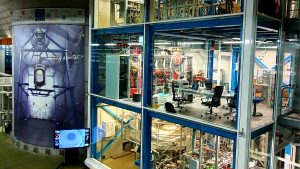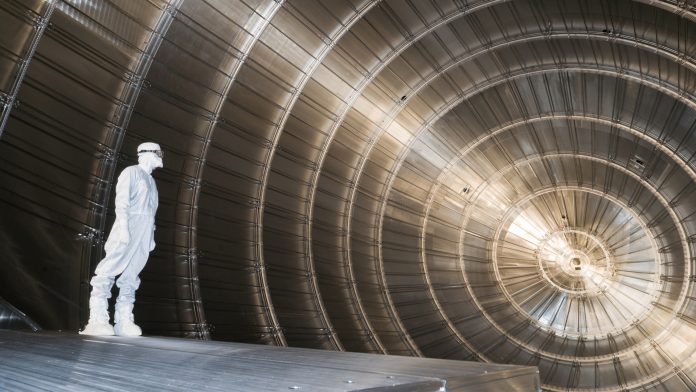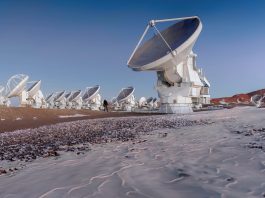Solving the common puzzles of cosmology, dark matter particles, and the mass of neutrinos using sensitive experiments requires continuous technological progress and, in particular, the extreme reduction of background due to residual traces of radioactivity.
With the term ‘physical cosmology’, the Nobel Prize for Physics in 2019 to J Peebles honours the close connection between modern cosmology and particle physics: the world of the enormously large and the world of the smallest particles are closely linked. With the laws of the so-called ‘Standard Model’ of particle physics and the theory of general relativity formulated by Albert Einstein more than 100 years ago and recently so well confirmed by the discovery of gravitational waves (Nobel Prize for Physics, 2017), the evolution of the Universe from its birth in the Big Bang about 13.8 billion years ago to its structure today can be described mathematically in great agreement with the experimental results.
Dark matter
However, despite all the mathematical beauty of the description and its agreement with the observations, there are still significant unanswered questions. For example, we know that one-sixth of the matter in the Universe is the atoms that make up our Solar System and all matter on Earth. But we do not know what the remaining five sixths are, the so-called ‘dark matter’, which embeds every galaxy in a ‘halo’ of gravitationally acting dark matter.
The structure of today’s Universe, consisting of countless clusters of galaxies and billions of galaxies, requires that this dark matter has been strongly clumped and cannot have moved too fast at the time when these structures were formed. That is why researchers have been searching for decades for as yet unknown heavy particles, so-called WIMPs (weakly interacting massive particles). If these particles really exist, they would interact with matter only very weakly, except by gravitation. Although they would have formed at high temperatures shortly after the Big Bang, with the expansion of the Universe they would have cooled down so much that they would have been sufficiently slow for structure formation. However, dark matter could be other, much lighter particles, e.g. so-called axions, whose generation mechanism in the early Universe was such that they could also explain the present structure of the Universe.

Two birds with one stone
What is fascinating about the various possibilities for the particles of dark matter is that their existence would simultaneously solve another important puzzle of particle physics. The axions would explain a particle-antiparticle symmetry that is still not understood but has been observed experimentally. The WIMP hypothesis is even called the ‘WIMP-Miracle’, because its existence would also solve an important particle physics problem: the current Standard Model urgently needs to be supplemented by further particles to ensure that it does not collapse mathematically at very high energies.
Physics has faced such missing particle problems several times before, and the missing particles have always been found, e.g. P Higgs as well as F Englert, R Brout, and others demanded the ‘Higgs’ particle in 1964, which was discovered at the European particle physics centre, CERN in 2012 (Nobel Prize for Physics, 2013). However, the hypothetical WIMPs have long eluded all efforts of physicists to discover them. How much longer do we need to wait, or do they not exist after all?
Neutrinos
One of the common puzzles of cosmology and particle physics is related to the neutrinos, by far the most abundant particles of matter in the Universe. Every second, 100 billion neutrinos fly through an area as small as a fingernail without us even noticing. Since these elementary particles, which occur in three flavours, are about one billion times more frequent than atoms in the Universe, it was long thought that they were the sought-after particles of dark matter. Since the discovery of the transformation from one flavour to another in flight (‘neutrino oscillation’, Nobel Prize for Physics, 2015), we even know that they do indeed have tiny masses. However, the clear structure of the Universe today, with the large voids between the countless galaxies, does not match the very small mass of neutrinos. If they were the only dark matter particles, these lightweights would have balanced out the mass distribution much more than we observe today.
Nevertheless, neutrinos are very important in the Universe because they are necessary in many important processes: the burning of stars or the explosion of heavy stars at the end of their burning period and the resulting production of a multitude of chemical elements of the periodic table would not work without neutrinos. Since neutrinos make up one, albeit small, part of dark matter, a precise knowledge of the mass of the neutrino is very important for understanding the structural evolution of the Universe.
Neutrinos and dark matter
These two cosmological and particle physics puzzles, the nature of dark matter and the unknown neutrino mass, could even be directly related: one class of hypothetical extensions of the Standard Model suggests that the extremely small mass of the neutrino, as opposed to the masses of other particles of matter, is due to the fact that neutrinos do not couple directly to the Higgs particle – as do all other elementary particles of matter – but to particles of dark matter.
The search for dark matter
Experimentally, the search for dark matter and the search for the neutrino mass are confronted with similar challenges. In the direct search for dark matter, the observation of a recoiling atomic nucleus is searched for, when a dark matter particle from the halo of the Milky Way, our galaxy, has scattered off an atom. Unfortunately, such a signal would occur in addition to some expected background events of other origins. For this reason, the signal events to be searched for must be made as frequent as possible by using the largest possible detectors with high detection efficiency and by continuously measuring under stable conditions over many years. But the signal is only expected to occur in a few events over many years. Therefore, the greatest experimental challenge is to reduce the number of background events to close to zero. To achieve this, the experiments are usually set up deep underground, e.g. in the Italian underground laboratory LNGS in the Gran Sasso massif. In such a location, the cosmic radiation is shielded by a factor of one million or more by the rock above the experiment. Still, only detector materials that can be manufactured with extremely small radioactive impurities are used. For example, the experiment that is just starting to search for WIMPs and other candidates for dark matter, XENONnT at LNGS, is using about eight ultra-clean tonnes of the noble gas xenon, which is kept liquid at -100°C.
The search for the neutrino mass
In the direct neutrino mass search from the beta decay of the hydrogen isotope tritium, the continuous electron energy spectrum near its upper end point features a little deformation depending on the size of the neutrino mass. This energy region needs to be measured with great precision but, unfortunately, the count rate approaches zero there. Thus, the major challenges in directly detecting the neutrino mass are: the background rate must be very low; the beta spectrum rate very high; and its spectral shape must be determined as precisely as possible.
The KATRIN experiment at the Karlsruhe Institute of Technology started its direct search for the neutrino mass about a year ago. Although it is built on the surface of the earth, it reaches an ‘artificial depth’: charged particles created on the approximately 700m2 large walls of the spectrometer by cosmic radiation are being deflected by means of electric potentials from a large wire electrode system and magnetic fields. Additionally, the necessary high precision require the measurement conditions of KATRIN not only to be known very precisely, but to be kept very stable over a period of years.
Common challenge: radon background
In order to meet the increasing requirements of ever larger and more sensitive experiments with respect to background rates, new technologies and methods must be continuously developed. This shall be illustrated here with some examples of the experiments XENONnT and KATRIN.
All efforts to reduce the background rate due to radioactive contamination practically always end with the fight against the radioactive isotopes of the noble gas radon, 219Rn, 220Rn, and 222Rn, and their decay progenies. The radon isotopes originate from decay chains of very long-lived uranium and thorium isotopes, which still originate from the ‘ashes’ of stellar explosions, from which our solar system was formed five billion years ago.

Removing radon at XENONnT
As a noble gas, radon easily escapes from all materials. It emanates from soil and rock as well as from house walls into the air, so that about 50% of the natural radioactive exposure of a human being is caused by radon. In the XENONnT detector, the isotope 222Rn also emanates from the detector construction materials and electrical cables, so that one of its decay progenies, 214Pb, is the main background source for the search for dark matter. To reduce this background rate, all materials were subjected to rigorous screening before the detector was built. On the other hand, a novel cryogenic distillation apparatus was developed, through which the liquid xenon of XENONnT will be continuously pumped, thereby removing radon.
A cryogenic distillation column with much smaller throughput had already been designed for the previous experiment XENON1T. It can reduce the radioactive isotope 85Kr, which is an impurity in the liquid xenon when xenon gas is extracted from air, extremely efficiently to one 85Kr atom per quadrillion (1024) of xenon atoms. This extreme reduction of the residual radioactivity therefore made XENON1T the most sensitive dark matter experiment to date.
XENON1T was able to discover the slowest process ever directly detected, a special kind of double beta decay: double electron capture. However, XENON1T could not yet find WIMPs, but at low energies it recently observed a small surplus of events, which can be interpreted as an indication for axions. Whether the signs for axions are confirmed or not will need to be clarified by the successor experiment XENONnT at LNGS, which will start at the end of 2020. Just a small comparison to classify the already extremely low background rate of XENON1T: in a human body, there are about 100 decays per second per kg of body weight due to the naturally occurring radioactive isotopes. The measured background rate in the ultrapure liquid xenon within the energy range of the XENON1T excess was only one event per kg per year, which is a billion times lower.
For XENONnT, an experiment that is ten times more sensitive than its predecessor, a distillation system for radon removal had to be developed that vaporises and liquefies 20 times more xenon in the same time. In order to provide the enormous cooling capacity while at the same time meeting the most extreme purity requirements, a ‘radon-free’ piston compressor driven by an ingenious arrangement of magnets was developed, as industrial products do not reach the required ultra-low radioactivity level. Together with heat exchangers developed in-house for the same reasons, the cryogenic system will be operated as a kind of heat pump. With this ‘green’ technology, a factor of three in cooling capacity is saved. Here again, the driving force behind the development of these new technologies is to reduce the background rate caused by radioactive decays to such an extent that the mysterious dark matter finally reveals its secret.
Avoiding radon at KATRIN
The radioactive radon isotopes also limit the sensitivity of the direct neutrino mass experiment KATRIN. In order to provide the enormous pumping power for the huge KATRIN spectrometer, so-called non-evaporable getter pumps are used to create a vacuum, which corresponds to that on the lunar surface. Unfortunately, these pumps emanate the short-lived radon isotope 219Rn, but a solution has been found for this problem as well: several large baffles cooled down by liquid nitrogen to -196°C freeze the radon before it can decay within the KATRIN spectrometer.
However, one radon-induced problem at KATRIN remains still open: because 222Rn is present in small traces in the air, atoms of the radon decay progeny 210Pb became implanted in the inner surface of the spectrometer during the setup of the experiment. If this and its decay progeny 210Po decay there, there is a small probability that highly excited but electrical neutral ‘Rydberg’ atoms will be ejected into the spectrometer without being hindered by the electrical and magnetic barriers of the artificial depth. There, the Rydberg atoms can be ionised by absorping thermal radiation and emitting an electron, which is counted as a supposed signal event. Even if this sequence of events may seem unbelievable at first glance, it was discovered and proven by physicists in meticulous detective work. Now, a new technological or methodological step to also eliminate this radon-induced background source is under development to increase the chances of the neutrino revealing its mass.
Co-operation and support
It should be highlighted that these technological developments, which are so important for the search for dark matter, the determination of the neutrino mass, and similar areas of basic research, were only made possible by the co-operation of strong universities possessing their own technology development capabilities and large research centres based on the support of the Federal Ministry of Research and Education (BMBF and its `Verbundforschung´) in Germany.
Experiments
KATRIN (www.katrin.kit.edu)
XENON (science.purdue.edu/xenon1t/?tag=xenonnt)
Professor Christian Weinheimer
Director Institute for Nuclear Physics
University of Münster
+49 251 8334971
weinheimer@uni-muenster.de
Tweet @WWU_Muenster
www.uni-muenster.de/Physik.KP/en
www.facebook.com/wwumuenster
www.linkedin.com/school/university-of-muenster
Please note, this article will also appear in the third edition of our new quarterly publication.









